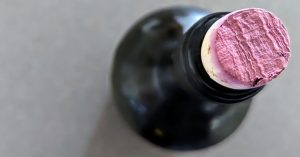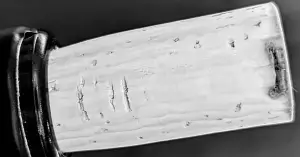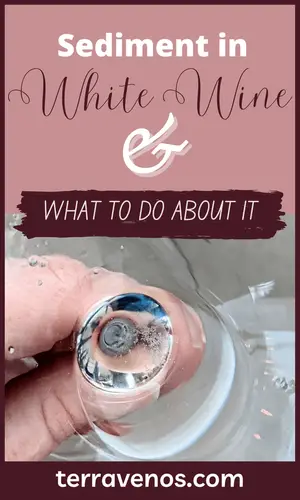
I went wine tasting with friends the other day, and the winery was pouring a white wine that left sediment in the glass. Sediment in white wine isn’t as common as sediment in red wine, but it can happen.
Sediment in white wine comes from harmless tartrate crystals. They’re naturally occurring and won’t harm you or affect the flavor of your wine. If sediment in the bottom of your wine bottle bothers you, you can decant (pour off) the wine into another vessel and leave the wine sediment behind.
If you’ve ever pulled out a white bottle of wine from the fridge and gone to pour your guests a glass only to realize there’s something floating inside, no doubt you’ve probably had two simultaneous questions pop up in your mind:
- What’s going on?
- Is the wine safe to drink?
What Causes Wine Sediment?
Most wine sediment comes from naturally occurring potassium bitartrate in the grapes.
Grapes are full of tartaric acid, a natural fruit acid. Tartaric acid helps give the fruity flavors in wine their zippy, juicy quality. Wines with insufficient tartaric acid can taste flat or dull.
Winemakers may actually need to add tartaric acid during the winemaking process if the grapes don’t have enough of their own natural acidity.
Adding acid to grape juice is increasingly important with warmer summers and in hot growing climates, like the Central Valley, in California.
Tartrate crystals come in three forms
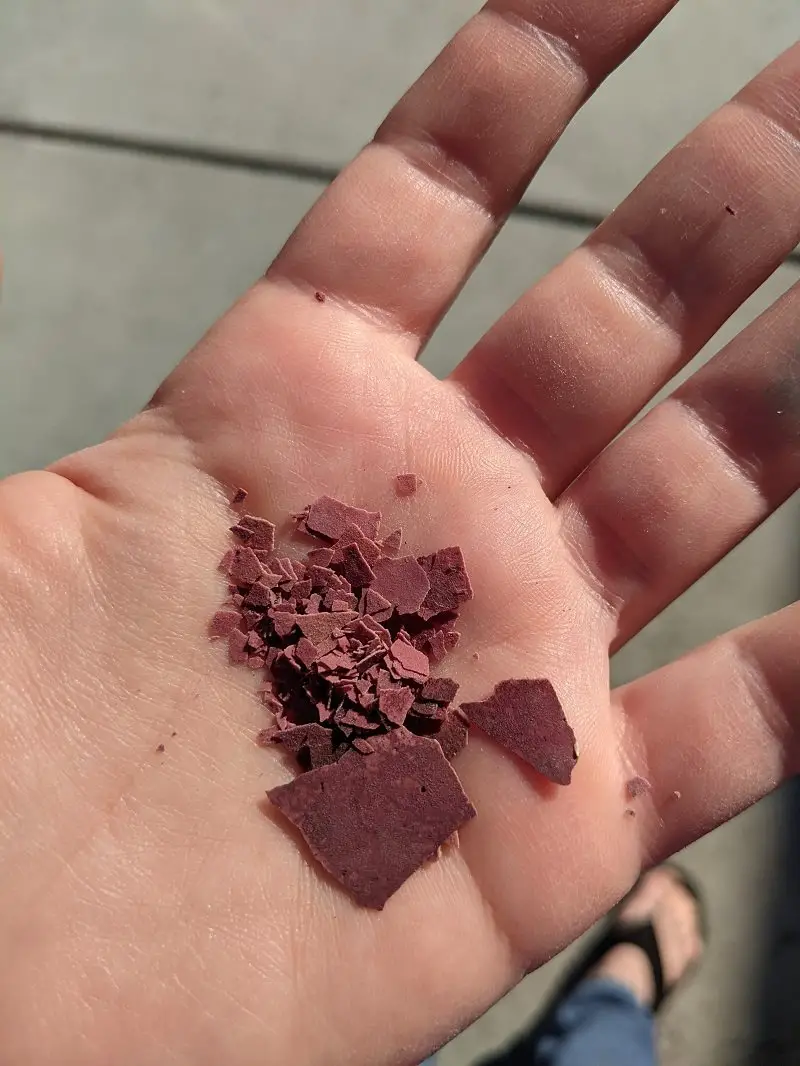
- Wine crystals in a clear cubical form, often falling to the bottom of the bottle like little diamonds, hence the mainstream term ‘wine diamonds’. Crystals can also form on the cork if the bottle has been lying down on its side for some time.
- Flakey tartrate crystals that form when a bottle of wine has been chilled down. These look like snow globe flakes. They will settle in the bottle of the wine if it’s sitting upright, but easily get disturbed again when the bottle gets moved.
- Potassium bitartrate that appears like sandy, soil-like sediment in older bottles of wine, or even some younger red wines that may have been bottled without being fined or filtered.
Tartrate crystals fall out of solution if the wine gets exposed to very cold temperatures for a few days.
Some winemakers put the wine through a process called cold stabilizing, where they chill the wine down (about 30°F for 3 weeks) in the winery to force the crystals to form.
They can then filter off the clean wine and bottle it.
Other winemakers may forego cold stabilizing.
Maybe it’s not part of their winemaking philosophy. Maybe they don’t have the proper equipment.
Maybe they don’t want to use up gobs of energy for a largely cosmetic effect.
If a producer is fortunate (or unfortunate) enough to live in a climate where it gets below freezing during the winter, they can simply leave the winery doors open and let Mother Nature work her magic chilling the wines down naturally.
Anyways, if the wine doesn’t go through the cold stabilization process at the winery and you happen to chill the bottle down in an over-zealous fridge, it’s likely to cause the crystals to form in your bottle.
Again, these are harmless and a pretty nifty kitchen chemistry reaction.
Sediment in White Wine: What Else Could It Be?
The other type of sediment a white wine may have come from yeast. This is uncommon, and more likely to happen in pét-nat wines.
Pétillant naturel, or pét-nat in short form, translates to natural sparkling, and will almost always have sediment.
This wine style is growing in popularity with the natural wine movement – what’s old is new again, no?
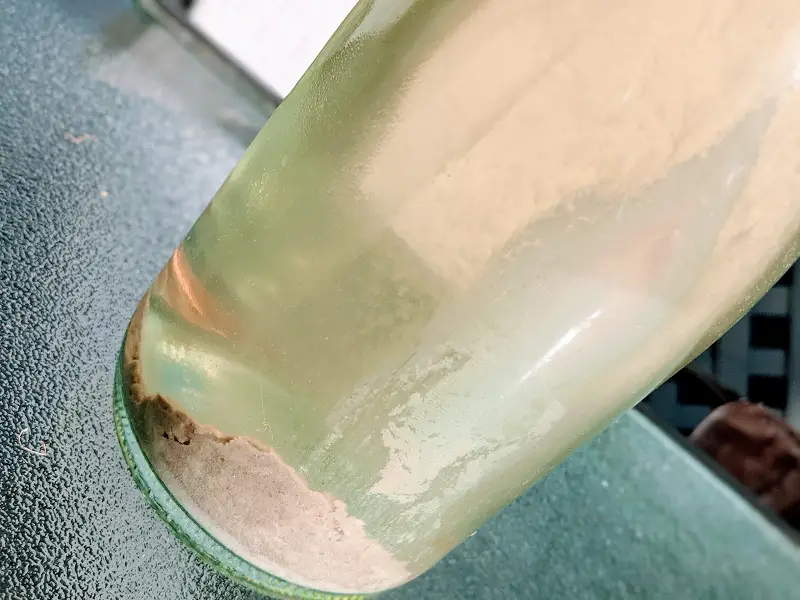
Winemakers drain off fermenting juice right before the fermentation is complete and bottle the wine while there’s still juice sugar (a.k.a, residual sugar) and active yeast (little alcohol and CO2 factories).
The yeast continue to metabolize the sugar in the bottle and the resulting wine is a spritzy dry wine that’s a ton of fun (read more about fermentation basics).
The yeast die off when they run out of food and oxygen, and their cells break down forming a layer of sediment, called lees.
When you open the bottle, the sediment will get mixed back into the wine, even if it’s been sitting in a layer on the bottom of the bottle.
You won’t be able to taste the sediment, but the wine in your glass may be a little hazy.
Are some wines more likely to have sediment?
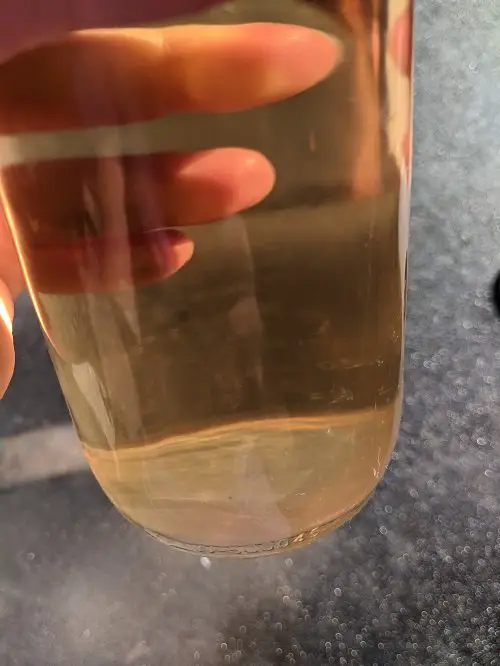
You’re more likely to notice sediment in white and rosé wines simply because the wine bottles are transparent and you can see whatever happens to be floating in them.
Other than that, older red wines will tend to throw off the finer, sandy sediment.
Unfined and unfiltered wines may also have more sediment in the bottle, but this will depend on how long the wine was aged before bottling.
Sediment will naturally fall out of the wine over time thanks to the magic of gravity.
If the wine’s aged for 18 months or 2 years back at the winery, a lot of that sediment will get removed before the wine arrives at your dinner table, even if it’s unfined and unfiltered (learn more about unfined and unfiltered wine here).
Does Sediment in White Wine Have Anything to Do with the Wine’s Quality?
Nope sediment in white wine has nothing to do with the wine’s quality. Sediment is a natural process and is perfectly normal. The best wines can have sediment fallout, even wines that cost hundreds of dollars.
Will sediment in wine hurt you?
No. Wine diamonds and wine sediment won’t hurt you. Wine sediment and wine tartrate crystals are tasteless, odorless, and harmless.
If you’re feeling particularly brave, go ahead and take a quick lick of a cork covered in tartrate crystals. You expect them to have a flavor, maybe salty or sweet, but they don’t.
Is It Okay to Drink Sediment in White Wine?
Wine diamonds are harmless, but it may still make you uncomfortable to drink a glass of wine with floaties. If you’re concerned about drinking sediment or would prefer not to have sediment transfer from the bottle into your glass, you have a few different options.
Option 1. If the bottle’s been sitting on its side and the sediment has collected along the neck or body, you’ll want to stand the bottle upright and let gravity work its magic before pouring.
If the sediment looks particularly heavy, consider doing this a few days before you plan to drink the wine.
When you’re ready to enjoy, uncork and gently pour the wine into your glass, careful to leave the sediment at the bottom of the bottle by watching for when the sediment starts to collect at the bottle’s shoulder.
Option 2. Use a wine decanter. This adds an extra step and an extra piece of equipment but may be an attractive option if you drink older and/or unfined and unfiltered wines regularly.
You can follow the steps in #1 above, but this time carefully pour the wine from the bottle into a decanting vessel. You’ll want to watch the neck and shoulder of the bottle to see when the sediment starts to collect right where the two join and stop pouring before the sediment has a chance to escape.
Check out this full on step-by-step video on decanting wine service restaurant-style.

Option 3. If you have a particularly special bottle that’s been cellared for a long time with layers of wizened sediment, consider using a wine cradle to transfer the bottle from cellar to table horizontally without disturbing the sediment. From there, you’ll carefully remove the foil and cork, wipe the inside of the bottle opening, and ever so carefully pour the wine into a decanter and from there to the glass (see video).
Option 4. Use a sieve. An unsexy but practical alternative that will accomplish the task quickly and doesn’t require intense concentration or open flames. Take your tea strainer or similar fine netted sieve and set it inside a small funnel. Pour the wine into your glass or a decanting vessel. Done.
Too much work?
Option 5. If the wine sediment doesn’t bother you or your drinking companions too much, ignore it and drink up. Cheers!
Will Wine Sediment Ever Go Away?
No, once the wine has a sediment layer in the bottle – whether crystalline or sandy – the only way to get rid of it is to pour off the wine, drink it, and recycle the bottle. Presto! You no longer have to worry about wine crystals.
Final Thoughts – White Wine Sediment Is Natural and Harmless
Whether you get to the bottom of your glass and discover some crystals, or see them swirling in your chilled white wine bottle, rest assured that wine diamonds and sediment are perfectly natural and part of the winemaking process.
Drink up and enjoy your wine!
Thirsty for More?
If you’re just getting started out with wine, I put together this helpful overview of food with wine pairing to get you started. Side note – I spend just as much time thinking about food with wine pairing as I do deciding what I’m going to eat every night. Utter hedonism. What can I say?
The best way to learn about wines is through side-by-side comparisons with wine flights. I highly suggest DIY wine flights. Check out this post I put together to get you started with wine flights.


